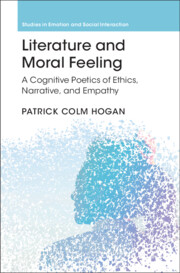Book contents
- Literature and Moral Feeling
- Studies in Emotion and Social Interaction
- Literature and Moral Feeling
- Copyright page
- Dedication
- Contents
- Figures
- Acknowledgments
- Introduction:
- Chapter 1 Defining Ethics
- Chapter 2 The Implied Ethics of Julius Caesar
- Chapter 3 Narrative Universals, Emotion, and Ethics
- Chapter 4 Ethics and Narrative Genre:
- Chapter 5 Emotion and Empathy
- Chapter 6 The Dynamics of Empathic Response:
- Chapter 7 Evaluating Empathy
- Chapter 8 The Critical Empathy of Angels in America
- Afterword:
- References
- Index
- Studies in Emotion and Social Interaction
Chapter 6 - The Dynamics of Empathic Response:
Simulation and Inference in A Midsummer Night’s Dream
Published online by Cambridge University Press: 21 April 2022
- Literature and Moral Feeling
- Studies in Emotion and Social Interaction
- Literature and Moral Feeling
- Copyright page
- Dedication
- Contents
- Figures
- Acknowledgments
- Introduction:
- Chapter 1 Defining Ethics
- Chapter 2 The Implied Ethics of Julius Caesar
- Chapter 3 Narrative Universals, Emotion, and Ethics
- Chapter 4 Ethics and Narrative Genre:
- Chapter 5 Emotion and Empathy
- Chapter 6 The Dynamics of Empathic Response:
- Chapter 7 Evaluating Empathy
- Chapter 8 The Critical Empathy of Angels in America
- Afterword:
- References
- Index
- Studies in Emotion and Social Interaction
Summary
In keeping with the pattern established in the first part of the book, the sixth chapter turns to a literary development of some key theoretical points, in this case examining how A Midsummer Night’s Dream guides empathic responses of audience members. More precisely, the processes of empathic understanding and emotion are highly complex in any real-world activity. That complexity involves repeated cycles of perception, recollection, inference, and simulation that are inseparable from one another, regularly providing the conditions for one another’s operation. (Simulation is a quasi-perceptual imagination of particular causal sequences that may be hypothetical and/or counterfactual, or they may simply serve to fill in unobserved aspects of an ongoing situation.) All these inferential and simulative processes are on display in our spontaneous and elective, automatic and effortful forms of empathic processing of literature. Through the analysis of A Midsummer Night’s Dream, the chapter illustrates some aspects of this complexity as it bears on empathic response.
- Type
- Chapter
- Information
- Literature and Moral FeelingA Cognitive Poetics of Ethics, Narrative, and Empathy, pp. 182 - 196Publisher: Cambridge University PressPrint publication year: 2022



